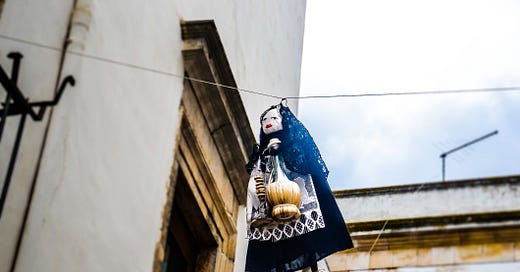La Befana takes to the air, Italy (Ilya Alisse, Getty Images)
On the eve of January 6, the Feast of the Three Kings, la Befana rides the north wind through ice and snow on a battered broomstick to visit homes where children have hung up their stockings or left their shoes by the fireside. She’s a tiny, hideous, ragged crone in a threadbare cloak but she carries an overflowing basket on her back, and she fills good children’s stockings with gifts of nuts and fruits, sweets and toys. Those who have not been so good—fie!—she leaves them lumps of charcoal (Italian parents used to warn their offspring “Stai buono se vuoi fare una bella Befana,” be good if you want a beautiful Befana). Her name is a demotic corruption of the word Epiphany, the feast day that celebrates the arrival of the three kings or magi to lay their gifts before the infant Jesus; she’s the Italian counterpart of traditional Christmas figures from other parts of Europe: of Saint Nicholas who became Santa Claus and, in the Low Countries, of Santa’s sidekick, the now highly controversial folk character Zwarte Piet (Black Peter).
Keep reading with a 7-day free trial
Subscribe to Book Post to keep reading this post and get 7 days of free access to the full post archives.




